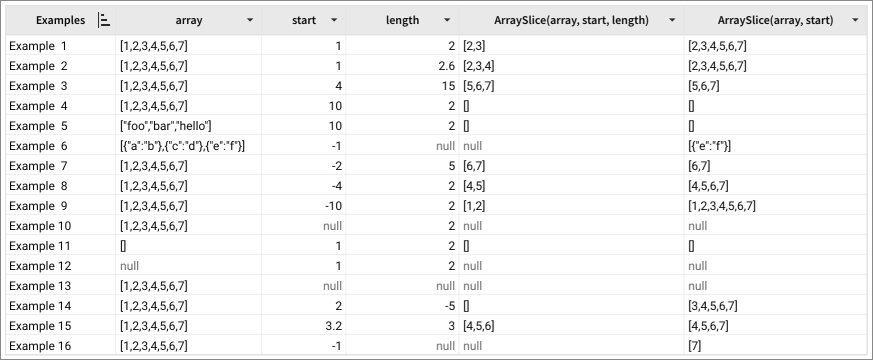ArraySlice
The ArraySlice function returns a portion of an array, defined by the starting index and length.
This function isn't compatible with all data platform connections. To check if your connection supports it, see Supported data platforms and feature compatibility.
Syntax
ArraySlice(array, start, length)
The ArraySlice function has the following arguments.
In general, if any of the arguments used by the function is Null, it returns Null.
- array
- Required.
- The input array that Sigma parses to extract a portion as a new array.
- Must be an array structure; to create single array from a column, use the ArrayAgg function.
- If this value is
Null, then Sigma does not return an array; see Example 12. - If the array is empty, Sigma returns an empty array; see Example 11.
- start
- Required.
- The beginning, or the starting index for extracting the new array from the original array.
- The range of valid valued are from
0toArrayLength(array) - 1. - If the value calculates beyond the end of the original array, Sigma returns an empty array, represented as
[]. See Example 4, Example 5, and Example 11. - Negative values count from the end of the array, so
-2is the second from the last position in the original array. - If this value is negative and the index calculates beyond the beginning of the original array, then the value
startdefaults to0. See Example 9. - If this value is negative and Sigma applies a
Nulllengthvalue, it does not return an array; see Example 6, column ArraySlice(array, start, length). - If both
startandlengthareNull, the function does not return an array; it evaluates to Null. See Example 13. - Sigma rounds floating numbers to the nearest integer; see Example 15, where the applied start is
3. - length
- Optional.
- The length of the new array.
- If there is no value (
Null) and Sigma applies it, then it does not return an array; see Example 6, column ArraySlice(array, start, length) - If the value is so large that the ending index calculates beyond the size of the original array, the function extracts from the start index to the end of the original array. See Example 3.
- If this value is negative, the function returns an empty array; see Example 14.
- If both
startandlengthareNull, the function does not return an array; it evaluates toNull. See Example 13. - Sigma rounds floating numbers to the nearest integer; see Example 2, where the applied length is
3.
Examples
The following examples of ArraySlice function demonstrate how this function works.

Updated 2 months ago
Related resources
